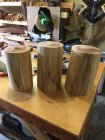I often turn some heavily spalted stuff that I find or people drop off at my shop. I'm sure you've all encountered grubs, ants and termites in spalted or aged wood that you turn. I've encountered nests of ants in crotch pieces and been covered in them along with all sorts of other critters. Sometimes I dig out the bug trail dust, sometimes I leave it and seal it with some CA. I've never had a piece I've finished have a grub or ant come crawling out after I've finished it but have come close and wondered what I would do if someone that bought one from me called to say termites were coming out of their bowl. I was about done with a piece a while back and decided to take a bit more off the bottom. Encountered a very large grub and had to go even deeper which made me wonder were there more entombed inside.
So, anyone do anything proactively to try and clear them out prior to turning or just plow through and deal with them as you go? I have a good sized elm log outside now that had a lot of termites and ants under the bark. I scraped the bark off but sure there are more inside. The wood core is still in good shape and looks ideal for a few hollow forms. I suspect there is really nothing to do other than turn away and deal with them as you find them and hope walnut oil seals any left inside forever.
So, anyone do anything proactively to try and clear them out prior to turning or just plow through and deal with them as you go? I have a good sized elm log outside now that had a lot of termites and ants under the bark. I scraped the bark off but sure there are more inside. The wood core is still in good shape and looks ideal for a few hollow forms. I suspect there is really nothing to do other than turn away and deal with them as you find them and hope walnut oil seals any left inside forever.
Last edited:

